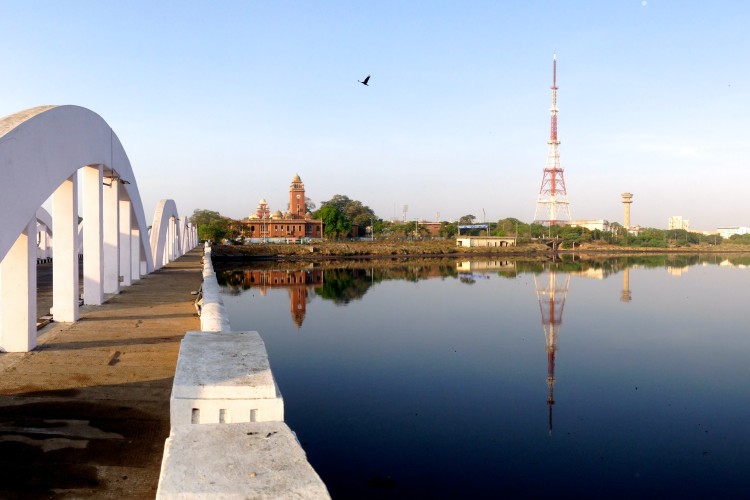
Chennai and its neighbouring districts are reeling under the impact of cyclonic storm Michaung, which has battered the north coastal areas of Tamil Nadu. The storm has claimed the lives of a dozen people, and officials are scrambling to conduct rescue and relief operations. This catastrophe serves as a stark reminder of the inadequacies in city planning and underscores the critical need to revamp urban planning strategies.
The region has been inundated with relentless rains, disrupting road, air, and rail transportation. The downpour has compelled major tech companies like Foxconn and Pegatron, both key suppliers for Apple’s iPhones, to suspend operations near Chennai. Flight operations at Chennai airport have been severely affected, leading to a surge in airfares on major domestic routes by up to 171%. The city’s residents are desperately stockpiling essentials, with a significant spike in demand for drinking water.
READ | Green hydrogen mission: Indian corporate giants vie for pole position
Recalling the 2015 deluge, which caused widespread power and internet outages, Chief Minister Stalin has insisted that the handling of the current situation is far more effective than it was during the AIADMK government’s tenure. The Chennai Municipal Corporation notes that the city has not experienced such heavy rainfall in 47 years. The devastation highlights how swiftly normalcy can be disrupted by natural calamities. Small and medium-sized enterprises, particularly in industrial estates, have been severely affected, and even large corporations have temporarily ceased operations for employee safety.
The need for overhauling urban planning
While natural disasters are inevitable, their impact can be mitigated through improved urban planning. Numerous surveys have pointed out the urgent need for an overhaul of urban spaces in India. According to a study by the think-tank Janaagraha, Indian urban planning lags significantly behind its wealthier counterparts, plagued by poor governance, limited fiscal autonomy, inadequate information, and weak public accountability. Except for a few cities, most Indian cities are poorly managed, with little attention paid to empowering local authorities.
By 2050, over 800 million people are expected to reside in Indian cities. To manage this growth, municipal bodies must be equipped to handle the increasing civic responsibilities. Currently, 39% of India’s state capital cities lack active spatial development plans, and only nine have comprehensive urban plans that include heritage conservation and sustainability. This issue is even more pronounced in smaller cities.
Cities like Mumbai, India’s financial capital, illustrate the stark contrast between affluent suburbs and slum areas where diseases are rampant. This disparity is evident in other cities like Delhi and Bengaluru as well. Policymakers attribute this to insufficient human resources dedicated to municipal tasks and a lack of administrative authority at the local level.
To improve the livability of Indian cities, it is essential to empower them to be self-sufficient. Policymakers need to devise strategies for wealthier citizens to contribute more financially and explore new funding sources for cities. Embracing advanced technologies and digital innovation is crucial for addressing issues like digital talent development, cybersecurity, and real-time project assessment.
Government efforts for better cities
In 2015, the Indian government launched the Smart Cities Mission, seeking to develop 100 cities with core infrastructure, a clean and sustainable environment, and a high quality of life, thereby spurring economic growth. The mission, with an allocation of Rs 48,000 crore over five years, has faced challenges. According to an IndiaSpend report, only 34 cities have met their targets, with the others lagging behind. Originally set to conclude by 2020, the mission has been extended to June 2024 due to delays, partly caused by the coronavirus pandemic.
By 2030, India is expected to have 60 cities with over one million residents and six megacities with populations exceeding ten million. This growth will strain infrastructure and civic amenities, necessitating rapid urban development to make these areas more liveable, sustainable, and resilient. India should look to international examples, such as the 15-minute city concept, to enhance the liveability of its urban centres.
Climate change, with its intensifying weather patterns, plays a significant role in amplifying the impact of such storms. The government must plan mitigation strategies like coastal protection systems, mangrove restoration, and green infrastructure development. These measures would not only offer physical protection but also contribute to environmental sustainability, creating a more balanced relationship between cities and their surroundings.
Local groups are often the first responders to disasters, providing essential support during recovery efforts. The communities should be empowered through initiatives like disaster preparedness training, communication network building, and resource allocation. By equipping communities with the knowledge and tools they need, we can build a more robust and resilient society, where everyone contributes to shared well-being.
By addressing issues like inadequate housing, lack of sanitation, and limited healthcare access, we can build cities that are not only liveable but also offer equal opportunities for all residents. By tackling the social determinants of vulnerability, we can build a more equitable and sustainable future for our urban centres.
